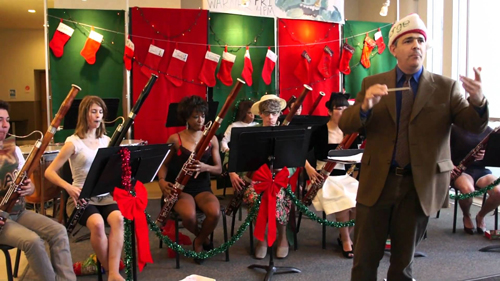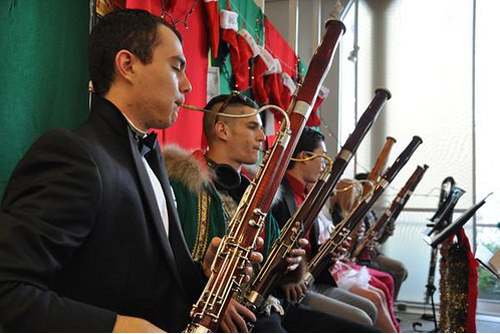by Jeremy Reynolds, guest contributor
courtesy of The Oberlin Review
There is perhaps only one commonality between the 2008 Summer Olympics, Harry Potter, the much-anticipated 2012 apocalypse and Georges Bizet’s beloved opera Carmen. It is true that two of these incidents feature music composed by John Williams and that two of these tales speak of great catastrophe. It is true that three of these four phenomena have occurred during the new millennium. But the only event that truly binds these disparate happenings together will take place on Thursday, December 11 at 12:30 pm, in the Conservatory Lounge. Immediately following Pizza with the Deans, Professor of Bassoon George Sakakeeny will celebrate his 25th anniversary of coordinating and conducting that jovial holiday tradition, Bassoon Christmas.
Sakakeeny began teaching at the Conservatory in 1989. His predecessor, Ken Moore, oversaw the first run of Bassoon Christmas. One of Moore’s former students, Mike Telin, OC ’84, recounted how one of his fellow bassoonists came up with the idea for a Christmas concert to blow off some steam during reading period.
“Ken was all for the idea,” he said. “We did the first one in flash mob style; we took over the lounge and started playing.”
Moore’s students so enjoyed the experience that they requested that Sakakeeny continue the series of quirky concerts when he took over Moore’s position. Sakakeeny said that he was happy to comply.
“I really like Christmas,” he said. “I have this major child inside me, and he’s very immature.”
During the mid-’90s, the students started to take over and add their own personal touches to the tradition, introducing elements such as costumes and a cheekily ribald advertising campaign.
The first Christmas carols featured in Bassoon Christmas were a small collection of arrangements passed from Moore to Sakakeeny in an old cardboard box. When the event began to gain traction, Sakakeeny started commissioning new arrangements for his students to perform to keep the music fresh. Out of the original box, only the transcription of selections from The Nutcracker is still regularly performed.
Currently, there is one man who handles all of the bassoonist’s arrangement work — Alan Montgomery (pictured above in blue sweatshirt). “Every year we usually have one or two new arrangements. We have an official arranger; we call him ‘court composer,’” said Sakakeeny.
Montgomery, formerly an assistant opera coach in the Conservatory, is beloved by students for his transcriptions; he is known for his ability to work standard excerpts from the bassoon’s orchestral repertoire into traditional carols. Sakakeeny said that most of the tunes that his students perform have Montgomery’s signature on them in one way or another.
These arrangements are consistently updated based on who is currently in the bassoon studio and whatever theme the performance is based on that year. Sakakeeny said that during one particularly memorable year, one of his students had begun her studies at the Conservatory as a flautist but quickly switched her major to bassoon performance. Montgomery arranged one carol to include an optional piccolo solo just for her. Similarly, Montgomery often included a part for Sakakeeny’s son, Nicholas, a percussionist who used to accompany his father’s students with timpani or tambourine.
Every year, Bassoon Christmas is centered around a distinct theme; this year’s theme is “Anniversaries,” in commemoration of the tradition’s 25th year under Sakakeeny’s baton. In 2007, the studio celebrated the publication of the final installment of Harry Potter by performing a medley of John William’s famously magical tunes from the cinematic adaptations. This arrangement will be featured again this year.
In 2009, the theme was the 2008 Winter Olympics, and the national anthems of both the United States and China were woven into various carols. Because of the specificity of these themes, Montgomery’s work is often unrecyclable, though Harry Potter is an exception. During the year that the Conservatory billed Bizet’s famous Carmen, some of the more famous bassoon tunes from the operatic score were cleverly hidden throughout a collection of Eastern European Christmas carols.
Like the revised arrangements, students adapt their costumes each year to coordinate with the theme. In 2012, the studio designed their costumes based on the Mayan calendar’s prophesy about the impending apocalypse.
“Someone was a zombie; someone was a cockroach,” Sakakeeny said. “Someone was a dolphin going back to their home in the stars.”
The wardrobe creativity will be present this year as well, according to Conservatory sophomore Corinne Crowley, who is preparing to perform in her second Bassoon Christmas. “We all work very hard on our costumes,” she said. But Crowley wouldn’t say what her costume would consist of this year.
Sakakeeny was similarly secretive. “I don’t know how people are going to dress up,” he said. “I’m going to dress up this year. I usually don’t.” When probed about what he would appear as next Thursday, he responded facetiously. “I couldn’t possibly say. I’d have to kill you if I told you.”
While Sakakeeny selects the arrangements and conducts the rehearsals and concert, he leaves the matter of advertising the performance to the students. According to Crowley, there is a party following the first rehearsal wherein everyone gets together to create those famously eye-catching recital posters that are summarily placed all over the campus. She described the process as nurturing, explaining that the poster party tradition helps the studio to bond.
When questioned about the risqué nature of the advertisements, Crowley said, “It’s very graphic. But that’s all meant as fun and games. I feel like the students would be disappointed if there weren’t graphic Bassoon Christmas posters everywhere.” Sakakeeny was emphatic that his part in Bassoon Christmas was entirely distinct from the advertisements. “I haven’t seen most of them. It has nothing to do with me,” he said. “I have absolutely zero involvement with the posters.”
Mary Kay Gray, associate dean of Student Academic Affairs, also participates in the effort to get the word out about Bassoon Christmas. “I’ve tried to make sure that other administrators across campus have the opportunity to participate,” she said. According to Gray, the concert is now listed as an official Conservatory tradition. “It just seems to bring an amazing amount of goodwill,” she said.
In 2011, Bassoon Christmas was featured in the Oberlin Conservatory Christmas card. Sakakeeny recounted that the studio was asked to perform “Winter Wonderland” and how there was no arrangement to date of that particular tune for a complement of bassoons. Montgomery whipped up an arrangement of the carol overnight, and the piece remains a staple to this day. “Winter Wonderland” is among the carols to be reprised this year.
To celebrate the 25th anniversary, Sakakeeny said that six alumni will return to campus to bolster the ranks of his studio, creating one of the largest Bassoon Christmas ensembles to date. He said that while alumni are always welcome to return, they are usually detained by professional obligations during the holiday gigging season. This year, however, one former student is actually taking two days of leave to participate in his former teacher’s quarter-centennial. According to Andrea Kalyn, dean of the Conservatory, “[Sakakeeny] has had an extraordinary class of alumni. I think that’s fantastic and that they are returning is a testament to the specialness of something like this.”
While the Conservatory lounge provides a fittingly relaxed atmosphere for the concert, the studio usually draws an enormous crowd that fills the lounge and extends down both hallways. When asked if there was any talk of moving Bassoon Christmas, Kalyn stated that the venue was an integral part of the tradition, and that moving the concert could cause the tradition to lose some of its appeal. “People can’t get by; they have to stop and listen,” she said.
Sakakeeny explained that the bassoon has a reputation for being a clownish instrument, and said that he has fought that stereotype throughout his 25 years of teaching at Oberlin. Sakakeeny rehearses with his students for between six and eight hours in preparation for the concert. “You’ve got to lay it down, and it has to be in tune, and it has to be good,” he said. “These things aren’t fun if they aren’t well done.”
According to Telin, one of the original bassoonists, “The event has come a long way since then, thanks to George.” The bassoon studio will begin rehearsing this Saturday and start tacking up posters this Sunday.
Concerning his plans for the future of Bassoon Christmas, Sakakeeny said “It has become something that absolutely must happen. Come hell or high water, it absolutely must happen.”
Jeremy Reynolds is a fourth-year student at Oberlin, pursuing degrees in English Literature and Clarinet. He is currently a member of the Introduction to Music Criticism class taught by Mike Telin, Daniel Hathaway and Donald Rosenberg.
Published on ClevelandClassical.com December 8, 2014.
Click here for a printable copy of this article






